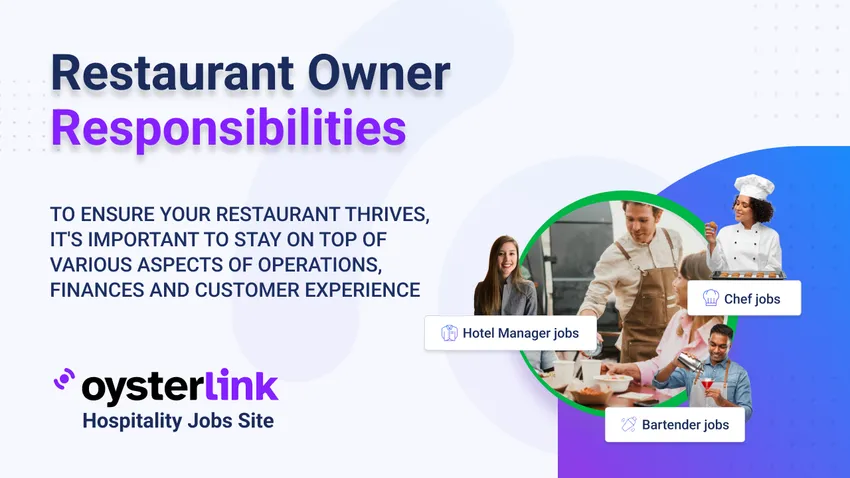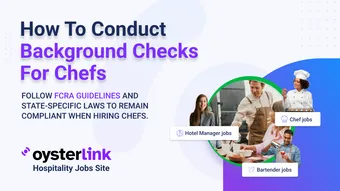Success in the restaurant industry includes juggling multiple responsibilities with finesse, and it's not just about having a great menu or the perfect location.
This guide explores the key restaurant owner responsibilities, providing you with insights and actionable tips on what it truly takes to run a successful restaurant.
1. Managing the big picture
Running a successful restaurant starts with having a clear sense of direction. As an owner, you’ll be responsible for defining your restaurant’s purpose, overseeing its financial health and planning for its future.
Defining the restaurant’s vision
Every great restaurant starts with a strong vision. As a restaurant owner, your job is to craft a concept that connects with the people you want to serve.
Understanding what your customers value is essential — tailoring your menu, atmosphere and service to meet their expectations is key to creating a dining experience they’ll want to return to.
Overseeing finances
Running a restaurant means more than just serving great food — it’s about making the numbers work. Owners are responsible for budgeting, tracking expenses and ensuring profitability. This includes:
- Monitoring revenue and expenses
- Managing cash flow to avoid shortfalls
- Setting realistic financial goals
Strategic planning
A restaurant operates as a long-term business, not just a daily routine. Strategic planning helps you stay ahead by anticipating industry trends, adapting to customer preferences, and growing your brand.
Think about whether you want to open additional locations, expand your menu or pivot when faced with challenges.
2. Overseeing day-to-day operations

Day-to-day operations are where your restaurant’s concept comes to life. As the owner, your attention to detail ensures a smooth workflow, happy customers and a profitable business.
Whether it’s refining your menu, managing inventory or maintaining efficiency, this is where your leadership directly impacts success.
Menu development and updates
Your menu is the centerpiece of your restaurant’s identity and a key driver of customer satisfaction.
Collaborate with your Chef to create offerings that align with your concept while balancing creativity and profitability.
Regular updates maintain the interest of returning customers. Consider adding specials or limited-time dishes to create buzz.
It’s also essential to analyze food costs and adjust prices or portions when needed to ensure each dish remains profitable.
Managing inventory and suppliers
Efficient inventory management is critical to avoiding waste or shortages. Build strong relationships with reliable suppliers to maintain consistent quality and negotiate favorable terms.
Regularly review your stock levels and use management tools to track inventory trends and prevent overordering.
Stock rotation is vital to minimize waste and keep ingredients fresh. Audit inventory regularly to identify slow-moving items and adjust orders accordingly.
Beyond food, ensure your non-perishable items — like cleaning supplies or packaging — are well-stocked to avoid operational disruptions.
Maintaining operational efficiency
A seamless workflow ensures your restaurant runs smoothly during every shift. Focus on optimizing your kitchen layout, dining room traffic flow and communication among team members to prevent bottlenecks.
Invest in modern tools like point-of-sale (POS) systems and inventory software to streamline operations and provide actionable data insights.
Regularly review order times and service feedback to identify areas for improvement.
Keep your equipment and facilities in top condition through regular maintenance. A malfunctioning kitchen appliance or poor dining room ambiance can disrupt operations and damage your reputation.
3. Building and leading a team
Your employees are the backbone of your restaurant. A strong, motivated team doesn’t just keep operations running — it shapes the customer experience, builds your reputation and drives your success.
As a restaurant owner, your role in team building extends beyond hiring staff. You’re responsible for fostering a positive work environment, providing ongoing support and setting high standards for performance.
Hiring and training staff
Your hiring process is critical to building a capable and cohesive team. Each hire, from skilled Chefs to personable Servers, contributes to the overall success of your operation.
To ensure you’re bringing in the right people, consider the following tips:
- Define roles clearly: Before hiring, outline detailed job descriptions that specify responsibilities, required skills and expectations. This clarity attracts candidates who align with your vision.
- Look for culture fit: Beyond technical skills, assess whether a candidate’s personality and values align with your restaurant’s environment. A strong culture fit helps maintain harmony among staff.
- Provide thorough training: Effective training ensures that your team is confident and competent. This includes teaching menu knowledge, service etiquette and safety procedures. Pair new hires with experienced employees to foster mentorship and collaboration.
- Invest in ongoing development: Training shouldn’t stop after onboarding. Offer workshops, certifications or team-building exercises to enhance skills and boost morale.
Managing employee relations
Creating a supportive and positive workplace culture is just as crucial as hiring and training. A happy and engaged team not only performs better but is also more likely to stay long-term.
Open communication is the foundation of strong employee relations. Regularly touch base with your team through meetings or informal chats to understand their concerns, hear their ideas and show that their input is valued.
Recognition is another key aspect of building a strong team. Employees who feel appreciated are more motivated and loyal.
Whether it’s acknowledging a job well done during a busy shift or celebrating milestones like work anniversaries, small gestures can have a big impact.
Equally important is addressing conflicts or challenges within the team promptly and constructively. Your leadership in resolving issues fairly will set an example for professionalism and mutual respect.
Supporting work-life balance is another way to foster a positive environment.
The restaurant industry can be demanding, but showing empathy through flexible scheduling or small perks like staff meals can go a long way in showing your team that they’re valued.
Setting and monitoring standards
High standards in performance and behavior create consistency and excellence, which directly impact customer satisfaction.
However, setting these expectations is only half the job — ensuring they are met is equally crucial.
What you need to do is:
- Define clear goals: Be transparent about what success looks like for each role, whether it’s reducing ticket times, upselling menu items or maintaining cleanliness standards.
- Lead by example: As the owner, your actions set the tone for your team. Demonstrating punctuality, professionalism and a strong work ethic inspires your staff to follow suit.
- Provide regular feedback: Performance reviews shouldn’t just be an annual formality. Offer constructive feedback often and highlight both areas for improvement and success.
- Address underperformance promptly: If an employee isn’t meeting standards, address it privately and constructively. Outline clear steps for improvement and provide the support they need to succeed.
- Incentivize excellence: Set up incentive programs that reward exceptional work, like bonuses for hitting sales targets or recognition for outstanding customer service.
Building a loyal and long-lasting team
Retaining employees is more cost-effective than constantly dealing with turnover. To build a loyal team, focus on creating growth opportunities, fostering a supportive environment and being transparent about your goals.
Offer clear pathways for advancement, like promoting from within or sponsoring management training, so employees can see a future with your restaurant.
Also, make sure employees understand your restaurant’s vision and their role in achieving it, so they feel more invested in the business’s success.
4. Managing Customer relations and marketing

Your relationship with customers is the heart of your restaurant's success.
Building meaningful connections, creating memorable dining experiences and spreading the word about your establishment are critical to standing out in a competitive market.
Creating a memorable guest experience
Customers return to restaurants not just for food but for the entire experience.
As the owner, your role is to ensure every interaction — from the initial reservation to the final farewell — is seamless and enjoyable.
To create a lasting impression, consider the following:
- Atmosphere: The lighting, music and decor should align with your restaurant’s concept, fostering an inviting and comfortable environment for guests. A well-crafted atmosphere can elevate the dining experience.
- Service: Train your staff to be attentive and courteous while maintaining professionalism. Small, thoughtful gestures, such as remembering a regular’s favorite drink, can make customers feel valued and more likely to return.
- Feedback: Actively encourage customers to share their thoughts, whether through surveys or casual conversations. Use this feedback to improve the experience and show guests that their input is important to you.
Marketing the restaurant
A strong marketing strategy is essential for driving traffic to your restaurant, especially in the digital age. While traditional advertising still plays a role, digital platforms offer cost-effective ways to reach your audience.
- Leverage social media: Share mouthwatering photos, highlight promotions and interact with followers on platforms like Instagram, Facebook and TikTok.
- Utilize online reviews: Monitor and respond to reviews on sites like Yelp and Google. Positive engagement can turn satisfied customers into loyal advocates.
- Offer promotions and events: Special deals, live music nights or themed dinners can attract both new and repeat customers.
Community engagement
Being an active part of your local community not only builds goodwill but also establishes your restaurant as a neighborhood staple.
- Collaborate locally: Partner with other businesses, like bakeries or florists, to create cross-promotional opportunities.
- Support local causes: Sponsor events, host charity fundraisers or donate to initiatives that matter to your community.
- Show appreciation: Organize “customer appreciation” events or loyalty programs to reward regular patrons.
5. Ensuring compliance and safety
No matter how appealing your menu or atmosphere, a single compliance or safety lapse can derail your business.
From securing the proper licenses to ensuring workplace safety, staying on top of legal requirements is crucial for maintaining a successful restaurant.
Legal and licensing responsibilities
Navigating the legal landscape of the restaurant industry can be complex, but it’s essential to ensure your business complies with all regulations.
Start by obtaining the necessary permits, such as food service licenses, liquor licenses, health permits and fire safety certifications.
Be proactive in staying updated on local laws and regulations, as these can change frequently.
Regularly review the guidelines to make sure your restaurant remains compliant.
Keeping detailed records is equally important; document everything from employee wages to vendor contracts, ensuring you're always prepared for inspections or audits.
Food safety and sanitation
Food safety is one of the most scrutinized aspects of the restaurant industry, and for good reason.
A single foodborne illness outbreak can destroy your reputation. To ensure food safety in your restaurant, consider the following steps:
- Train your staff: Make sure all employees are properly trained in safe food handling, storage and preparation techniques.
- Conduct regular inspections: Regularly inspect your kitchen to ensure compliance with health codes, especially focusing on refrigeration, cooking temperatures and cleanliness.
- Implement strict cleaning protocols: Develop and enforce daily, weekly and monthly cleaning schedules to maintain high standards of sanitation across your restaurant.
- Monitor food safety equipment: Ensure that thermometers, food storage units and other equipment used in food safety are regularly calibrated and maintained.
Workplace safety
Your employees are your greatest asset, and their safety should always be a priority. To minimize accidents, conduct regular safety training to prevent injuries like slips, burns and cuts.
Ensure that all kitchen equipment is in good working condition and meets safety standards.
Furthermore, develop emergency preparedness plans, provide first aid kits and train staff on how to respond to situations like fires or medical incidents.
6. Managing challenges and staying resilient
The restaurant industry is full of challenges, but successful owners know how to adapt and persevere.
Handling unforeseen issues
Unexpected problems are a part of restaurant ownership, but how you handle them can determine your success. Here are key strategies to respond effectively when challenges arise:
- Be proactive: Regular maintenance of equipment and a clear, well-documented workflow can help you avoid common disruptions before they escalate.
- Have a contingency plan: Prepare for potential problems like power outages or supply chain delays by developing backup solutions that keep your operations running smoothly.
- Adapt quickly: Flexibility is essential. If foot traffic decreases, pivoting to online orders or offering delivery services can help maintain revenue and meet customer demands.
Staying motivated and avoiding burnout
The demanding nature of the restaurant business can lead to stress and burnout if you’re not careful.
Prioritizing your well-being will allow you to give your best to your business and maintain a sustainable approach to ownership.
One way to avoid burnout is by delegating tasks. Trusting your team to handle day-to-day operations will give you the space to focus on the bigger picture, such as strategic growth and long-term planning.
Setting boundaries is also key. While it’s tempting to pour all your energy into the restaurant, it’s important to make time for yourself, family, hobbies and relaxation. This balance will help you recharge and maintain a clear perspective.
Lastly, celebrate your wins. Acknowledging milestones — whether it’s surviving the first year, earning rave reviews or reaching your revenue goals — helps remind you of why you started this journey.
These moments of celebration can reignite your passion and motivate you through the challenges ahead.
Navigating Restaurant Owner Responsibilities With Confidence
Owning a restaurant means wearing many hats — from visionary to manager to marketer. It’s a demanding role, but with preparation and dedication, it can be incredibly fulfilling.
If you’re feeling overwhelmed or unsure about where to start, platforms like OysterLink can help.
OysterLink connects restaurant professionals with industry insights, career advice and all the tools to support your journey in the industry.










Loading comments...